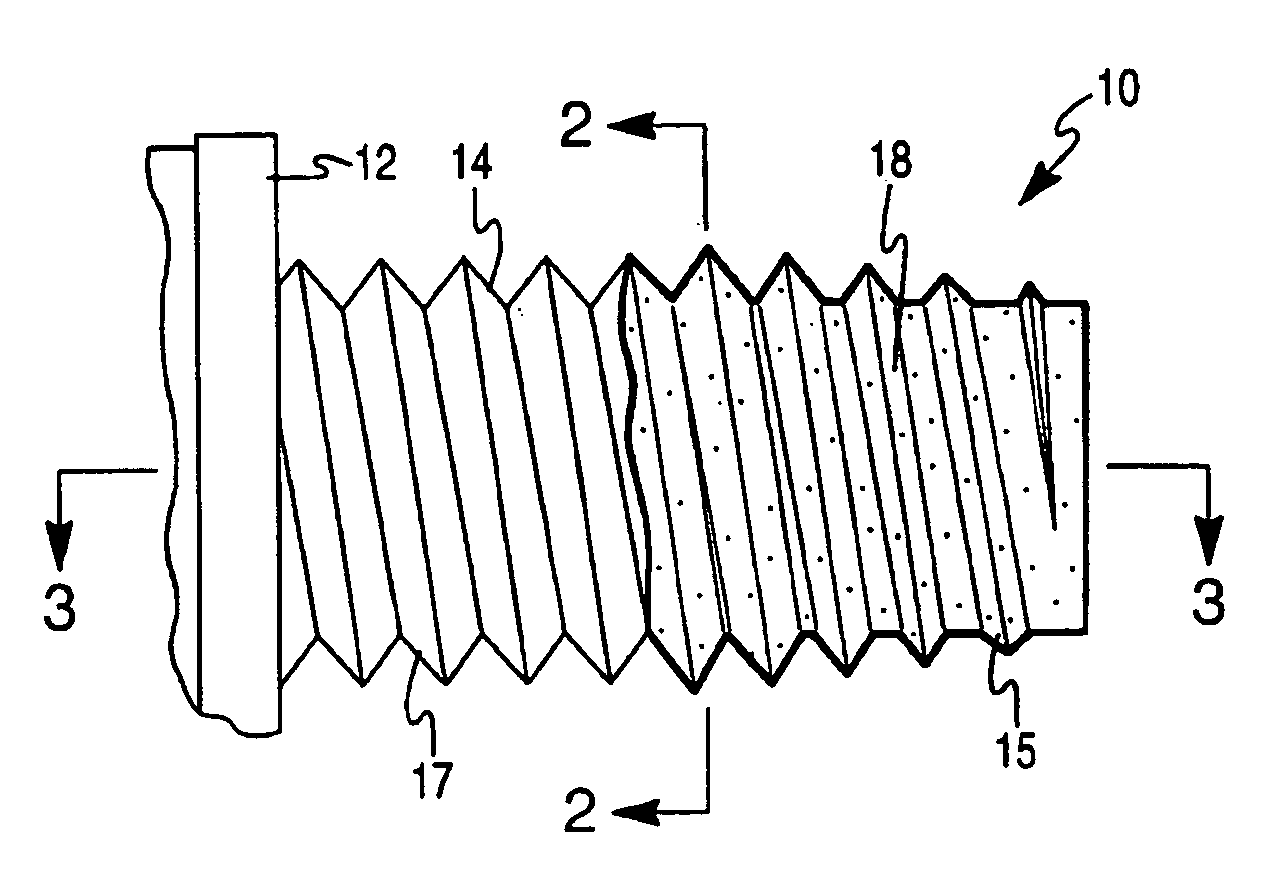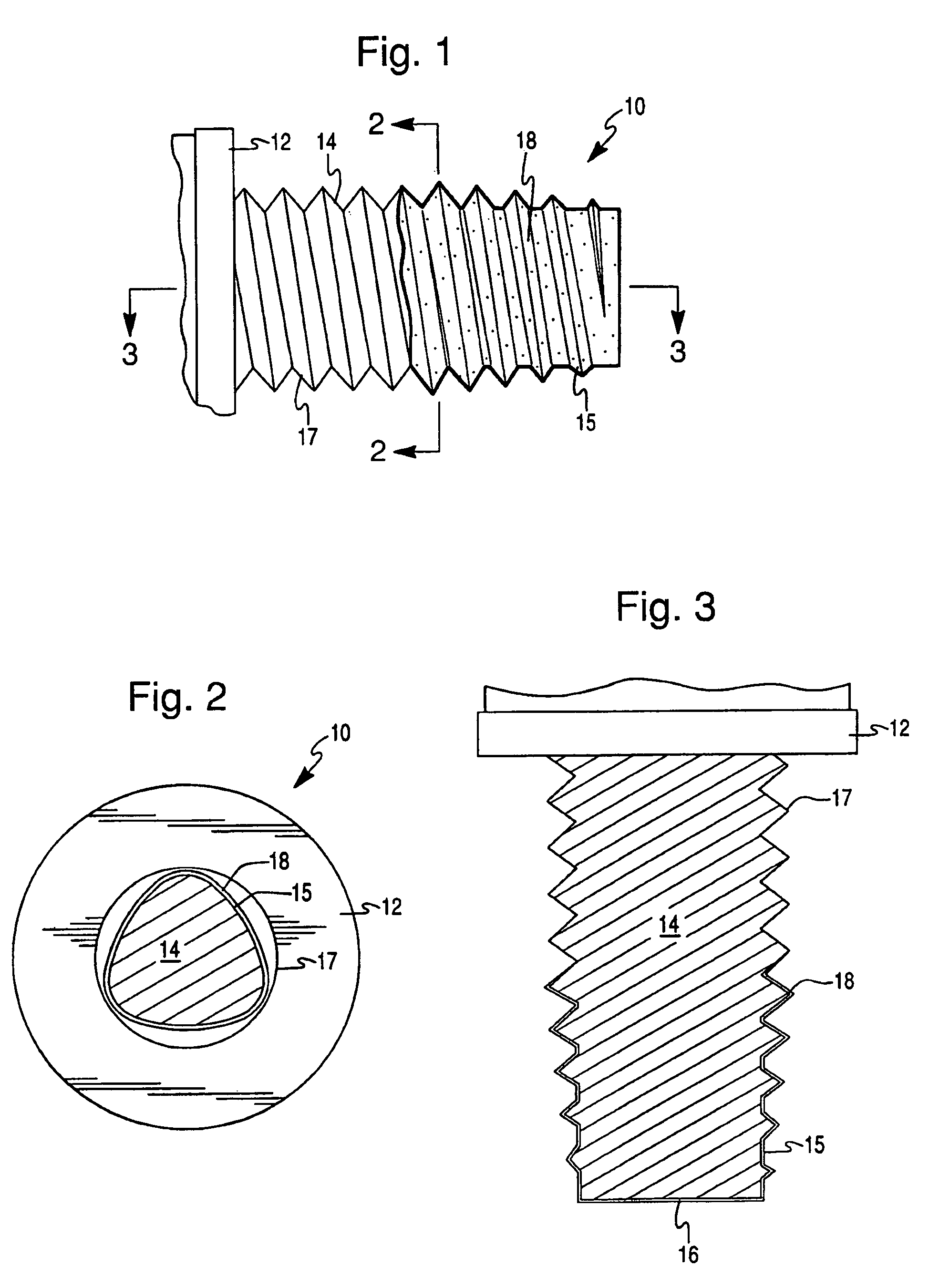Lubricant composition, fastener coated with same, and methods for making and using same
a technology of fasteners and compositions, applied in the direction of threaded fasteners, screwing, manufacturing tools, etc., can solve the problems of over-tightening or under-tightening of the fasteners within the workpiece, affecting the manufacturing efficiency, the performance and appearance of the finished joint, and the fluctuation of torque, so as to reduce the requirement of frictional forces and torque, reduce the peak installation torque value, and the effect of high consistency
- Summary
- Abstract
- Description
- Claims
- Application Information
AI Technical Summary
Benefits of technology
Problems solved by technology
Method used
Image
Examples
example 1
[0052]A size M-12 Tap-Tite 2000 self-threading fastener coated with the lubricating composition was driven into low carbon rolled steel test plate having a thickness of 10.4 to 10.8 mm and a hole size of 11.2 mm. This procedure was repeated 10 times, with the results reported in Table 4 below:
[0053]
TABLE 4(M-12 Fastener)Maximum threadMaximum threadforming torqueforming torqueTrial #(N · m)(in · lbs)116.1142.49214.2125.67315.3135.41415.1133.64513.7121.25616.1142.49713.4118.59816.6146.91916.1142.4910 12.3108.86Average14.89131.78Standard Deviation1.4312.64
[0054]The maximum required thread forming torque for the first set of examples was 14.89 N·m, which was less than 60% of the maximum torque permitted under the Ford specification standard of 25 N·m (see Table 1) and within the preferred ranges of Tables 2 and 3.
example 2
[0055]The procedures set forth above were repeated for M-6, M8, and M-10 Tap-Tite 2000 self-threading fasteners. The fasteners were driven into low carbon rolled steel test plates each having a respective thickness and hole size set forth in Table I and consistent with the Ford specification. The tests were repeated 30 times, and the results are reported below in Table 5.
[0056]
TABLE 5Maximum thread forming torque (N · m)Trial #M-6M-8M-10 12.85.710.4 22.55.110.9 32.85.111.1 42.75.411.2 52.95.610.4 62.96.211.2 72.45.410.4 82.95.210.7 92.75.211.7102.95.110.9112.65.510.4123.75.110.41335.810.7142.55.610.1152.75.610.9162.65.410.5172.75.610.4182.55.510.21935.510.7202.65.411.0212.65.510.7222.75.610.3232.75.010.1242.36.211.3252.85.510.8263.15.611.0272.96.110.5282.45.610.7292.75.510.4302.75.410.5Average2.7435.0010.683Standard0.2640.3030.381
[0057]The average maximum thread forming torque for the M-6, M-8, and M-10 fasteners were 2.743, 5.00, and 10.683 N·m, respectively. These values far excee...
example 3
[0058]TAPTITE 2000 ® M12-1.75×43 mm TORX® Pan Head, CORFLEX®-I thread forming fasteners with a mechanical zinc finish per Ford specification S437M were tested in weld nuts (Ford Part No. N807995) of less than one screw diameter length and engagement. The weld nuts were steel, having a hardness of Rb 94 plain finish, a hole internal diameter of 11.23 millimeters, a thickness of 11.88 millimeters, and engagement of 9.1 millimeters. All the self-threading fasteners were from the same manufacturing lot and material and heat-treated in the same batch. Twenty of these self-threading fasteners had a lubricating composition of the present invention applied to approximately five threads of each of the fastener shanks measured from the tip of each fastener by dip-coating them in the composition. The lubricating composition was dried to the touch at the time of the test. All of the coated fasteners were driven at 270 rpm and thread forming torque was recorded. Torque and angle were sensed by a...
PUM
 Login to View More
Login to View More Abstract
Description
Claims
Application Information
 Login to View More
Login to View More - R&D
- Intellectual Property
- Life Sciences
- Materials
- Tech Scout
- Unparalleled Data Quality
- Higher Quality Content
- 60% Fewer Hallucinations
Browse by: Latest US Patents, China's latest patents, Technical Efficacy Thesaurus, Application Domain, Technology Topic, Popular Technical Reports.
© 2025 PatSnap. All rights reserved.Legal|Privacy policy|Modern Slavery Act Transparency Statement|Sitemap|About US| Contact US: help@patsnap.com


